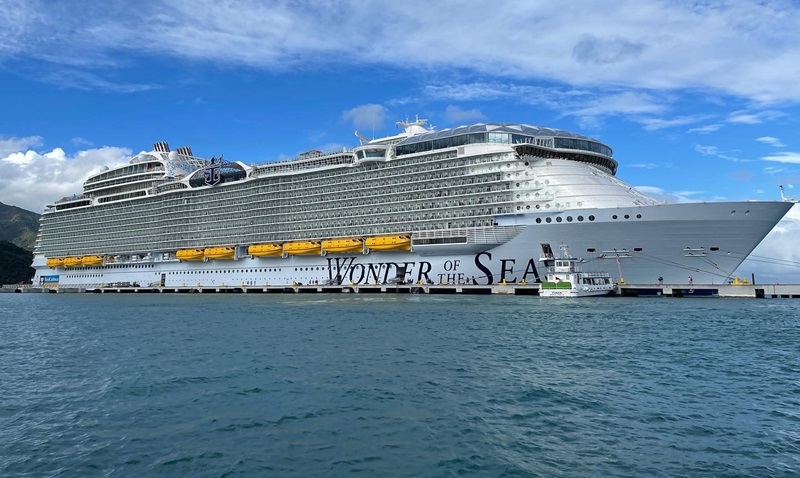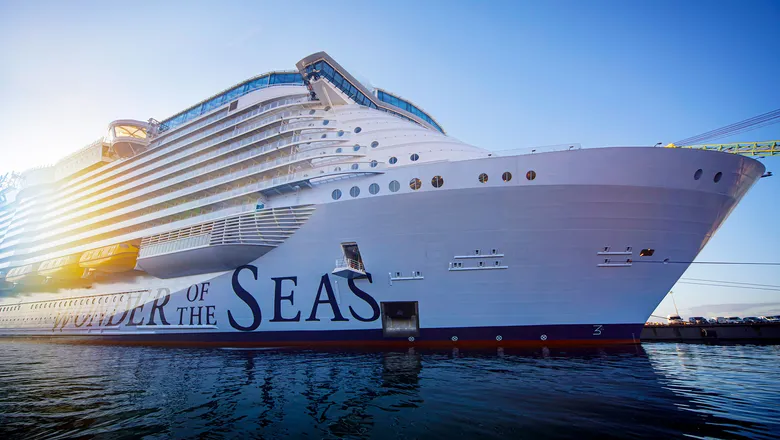Icon of the Seas, a marvel of marine engineering and luxury travel, has embarked on its maiden voyage from the bustling port of Miami. The vessel, hailed as the world’s largest cruise ship, is a testament to the remarkable evolution of cruise travel, underscoring the industry’s commitment to sustainability and eco-friendly practices. It’s a behemoth, measuring a staggering 1,188 feet in length with an astounding capacity to accommodate up to 6,988 passengers and 2,300 crew members, making it a floating metropolis on the high seas.
The ship is a spectacle to behold, boasting a plethora of state-of-the-art amenities and innovative features that redefine the cruising experience. From the tallest slide at sea to the iconic North Star observation capsule that offers 360-degree views of the surrounding ocean, the Icon of the Seas is a veritable floating entertainment hub. The ship also hosts a variety of exquisite dining options, spanning different global cuisines, a dazzling casino, Broadway-style theatres, and an array of retail outlets that cater to every passenger’s whim and fancy.
However, the Icon of the Seas isn’t just about grandeur and luxury. The ship is a pioneer in sustainable cruising, powered by liquefied natural gas, the cleanest burning fossil fuel, and featuring cutting-edge technologies to reduce its environmental footprint. It has been meticulously designed to recycle all water used onboard and employs advanced waste management systems. Even its hull design and the innovative air lubrication system contribute to reducing fuel consumption and cutting emissions.
Embarking from the vibrant city of Miami, the Icon of the Seas offers a diverse range of itineraries to some of the most sought-after destinations on the planet. From the sun-soaked beaches of the Caribbean to the cultural tapestry of Europe, the ship offers passengers an unparalleled voyage of discovery. The cruise ship also offers an assortment of shore excursions, carefully curated to cater to different passenger interests, whether it’s history, adventure, or local cuisine.
The Icon of the Seas signifies the dawn of a new era in cruise travel, offering the perfect blend of luxury, entertainment, and sustainability. It’s a floating testament to human innovation, pushing the boundaries of what’s possible on the high seas. Its maiden voyage is a significant milestone in the history of cruise travel, setting a new standard for future ships to follow. In every sense, the Icon of the Seas is a spectacular symbol of maritime achievement and ambitious vision, embarking on a journey that promises to revolutionize the cruising experience for travelers worldwide.

A New Era in Luxury Cruising
The world of luxury cruising is about to shift into an exciting new era, marked by an emphasis on opulence, technology, and sustainability. The maritime industry is consistently seeking ways to enhance the guest experience by pushing the boundaries of design, comfort, and entertainment. The new generation of luxury cruise ships is set to redefine the concept of extravagance at sea with penthouse suites, private butler service, and Michelin-starred chefs curating exquisite dining experiences.
In addition to lavish amenities, these ships are also incorporating advanced technology to elevate the cruising experience. From smart cabins that adapt to guests’ preferences to virtual reality experiences and high-speed internet connectivity in the middle of the ocean, technology is playing a pivotal role in transforming luxury cruising.
However, the industry isn’t solely focused on material opulence and advanced technology. Conscious cruising is becoming a significant trend, with more companies investing in eco-friendly measures to lessen their footprint. Modern luxury cruise liners are being equipped with advanced waste treatment systems, energy-efficient lighting, and increasingly relying on LNG (Liquefied Natural Gas), which significantly reduces emissions compared to traditional marine fuels.
Moreover, itineraries are becoming more immersive, designed to offer guests a deeper connection with the destinations they visit. This shift is marked by longer stays in port, a greater focus on local cultures, and even excursions led by local experts aimed at providing an authentic experience.
In conclusion, the new era of luxury cruising is set to be a harmonious blend of decadence, innovation, sustainability, and cultural immersion. This transformation is likely to attract a new wave of travelers, eager to explore the world while enjoying unparalleled luxury and comfort, underpinned by a commitment to preserve the planet’s beauty. The future of luxury cruising is looking more exciting and dynamic than ever before.
Impact on the Cruise Industry
The global cruise industry has experienced significant disruption due to various factors, most notably the COVID-19 pandemic. Prior to the pandemic, the industry was experiencing a period of substantial growth, with an increasing number of passengers choosing to spend their vacations aboard luxury liners. However, the onset of the pandemic led to numerous voyages being cancelled or postponed, resulting in substantial financial losses.
Moreover, the industry’s reputation has been tarnished due to several high-profile outbreaks of the virus on cruise ships, leading to a decrease in consumer confidence. On the other hand, the shift towards sustainable and environmentally-conscious travel is also reshaping the industry. Cruise companies are now being compelled to invest in eco-friendly technologies and practices in response to increasing consumer demand for sustainable tourism. The industry’s resilience is being tested, and it is apparent that its future will depend on its ability to adapt and innovate in the face of these challenges.
![]()
What to Expect on Board
When embarking on a journey by ship, plane, or train, it’s essential to know what to expect on board to ensure a smooth and enjoyable trip. The experience typically starts with boarding, which can sometimes be a tedious process, but patience and cooperation with the crew can make it easier. Once on board, you will find a variety of facilities and amenities designed to make your journey comfortable.
For instance, in an airplane, you may have access to in-flight entertainment, meals, and refreshments, all depending on the duration of the flight and the class of your ticket. On a cruise ship, expect a plethora of entertainment options ranging from live music, theater performances, swimming pools, gyms, and even casinos. Trains, particularly long-distance ones, typically offer dining cars, sleeper cabins, and sometimes even Wi-Fi.
However, regardless of the mode of transportation, passenger etiquette is important for maintaining a pleasant environment. This includes being respectful to fellow passengers by minimizing noise, keeping your area clean, and avoiding occupying extra space. It’s also essential to follow the instructions of the crew for your safety and convenience.
Understanding the rules and regulations related to luggage is another crucial aspect. Each transportation company will have its own weight and size restrictions, as well as guidelines on what can be carried on board. Some may also have specific requirements for electronic devices.
While every journey might differ depending on the type of transport and the company operating it, these are some of the general things you can expect on board. Being prepared and knowing what to anticipate can help you navigate any potential challenges and make the most of your travel experience.
Voyage Details and Itinerary
A voyage entails more than just embarking on a journey; it’s a meticulously planned expedition, often involving long distances, predominantly by sea. The core features of a voyage are the details and the itinerary, which determine the course of the journey. The voyage details usually encompass the departure and arrival dates, the duration of the journey, the type of vessel to be used, the crew involved, and the supplies needed for the journey. These specifics serve as a comprehensive overview of what the voyage entails and act as a blueprint for its execution.
On the other hand, the itinerary is a detailed plan or route of the journey. It outlines the stops or destinations to be visited, the activities to be undertaken at each stop, and the time to be spent at each location. The itinerary also covers contingencies, such as alternative routes or backup plans in case of unforeseen circumstances like adverse weather conditions.
Creating a detailed and well-thought-out itinerary is crucial for the voyage’s success. It helps in ensuring the optimum use of resources and time, avoiding unnecessary detours or wastage of provisions. Moreover, an itinerary also aids in maintaining the crew’s morale and motivation, as they have a clear understanding of the journey’s progression and their roles in it.
In conclusion, voyage details and itinerary are fundamental to any journey by sea. They provide a structured plan and a roadmap, guiding the voyage from the start to the end. Whether it’s a scientific expedition, a pleasure cruise, or a commercial journey, a well-planned voyage with carefully thought-out details and itinerary ensures a successful and fruitful journey.

Passenger Reactions
Passenger reactions can vary greatly depending on the situation or circumstance. When traveling, passengers may experience a myriad of emotions that can be triggered by various factors such as delays, the behavior of fellow travelers, or the conditions of the transport vehicle. In some cases, passengers may react positively, expressing satisfaction and contentment. This is often the case when the journey proceeds smoothly, fellow passengers are considerate, and the staff are courteous and professional. Such positive reactions can manifest in the form of commendations, generous tipping, or repeat patronage.
However, on the other hand, passengers may also respond negatively. This tends to happen when their travel experiences are fraught with inconveniences or discomfort. Delays, rude staff, or unruly fellow passengers could incite feelings of frustration and anger. These negative reactions could result in complaints, poor reviews, or even confrontations.
It’s also worth noting that passenger reactions can significantly impact the atmosphere within the transport vehicle. For example, in an airplane, a calm and content passenger can contribute to a tranquil and serene environment. Conversely, an irate passenger can create tension and unease, potentially ruining the travel experience for others.
In essence, passenger reactions are a critical aspect of travel and transport. They provide valuable feedback for service providers, allowing them to identify areas of improvement and enhance their service delivery. Furthermore, understanding and managing passenger reactions can also play a crucial role in maintaining order and peace during travel, ensuring a pleasant experience for all involved. Therefore, it’s essential for transport companies to pay close attention to passenger reactions, taking measures to foster positive responses and address any issues that may provoke negative ones.
